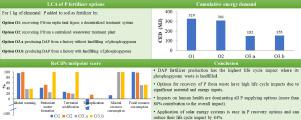Resources, Conservation and Recycling ( IF 11.2 ) Pub Date : 2021-06-22 , DOI: 10.1016/j.resconrec.2021.105750 Snigdha Goel , Arun Kansal , Stephan Pfister

|
Life cycle assessment of three sources of phosphorus (P) to agriculture is presented, comprising a conventional source, namely a chemical fertilizer (DAP, or diammonium phosphate), and two alternative sources, namely P recovered from septic tank liquor (decentralized system) and that recovered from sewage sludge (centralized system). Impacts of each option on the following aspects were measured using the ReCiPe methodology, in addition to the total impact: global warming, formation of particulate matter, terrestrial acidification, eutrophication of freshwater, and consumption of non-renewable resources (fossil fuels and minerals). The cumulative energy demand of each option was also estimated. The three options differed in terms of their impact on environmental externalities. The energy demand of DAP production was the lowest, and its impact on global warming was 38% of decentralized system and 37% of the centralized system. Production of DAP was associated with maximum mineral resource consumption because of extraction of rock phosphate. The decentralized system had the least impact on eutrophication of freshwater and most on particulate matter formation. Overall, the centralized system had the highest impact score – 2.3 times that of DAP production – followed by decentralized process, its impact being 1.4 times that of DAP production. If the phosphogypsum waste produced in manufacturing DAP is landfilled, DAP production had highest overall impact. The decentralized system was better than the centralized system – impacts lower by 40%. Change of source of energy from coal to solar power makes the centralized system most favourable option and is thus recommended for implementation.
中文翻译:

为农业采购磷:印度三种选择的生命周期评估
介绍了对农业磷 (P) 的三种来源的生命周期评估,包括传统来源,即化肥(DAP,或磷酸二铵)和两种替代来源,即从化粪池液体中回收的磷(分散系统)和从污水污泥中回收的(集中式系统)。除总影响外,每个选项对以下方面的影响均使用 ReCiPe 方法进行测量:全球变暖、颗粒物的形成、陆地酸化、淡水富营养化以及不可再生资源(化石燃料和矿物)的消耗. 还估计了每个选项的累积能源需求。这三个选项在对环境外部性的影响方面有所不同。DAP生产的能源需求最低,其对全球变暖的影响分别为分散式系统的 38% 和集中式系统的 37%。由于磷酸盐岩的提取,DAP 的生产与最大的矿物资源消耗有关。分散系统对淡水富营养化的影响最小,而对颗粒物形成的影响最大。总体而言,中心化系统的影响得分最高——是 DAP 生产的 2.3 倍——其次是分散过程,其影响是 DAP 生产的 1.4 倍。如果 DAP 制造过程中产生的磷石膏废物被填埋,则 DAP 生产的总体影响最大。去中心化系统优于中心化系统——影响降低 40%。











































 京公网安备 11010802027423号
京公网安备 11010802027423号